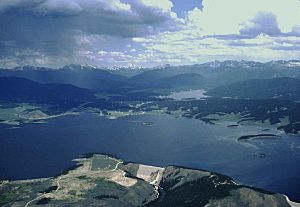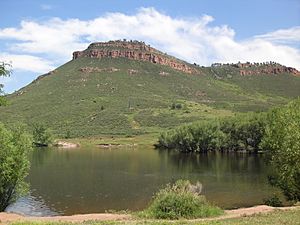Colorado-Big Thompson Project facts for kids

The Colorado-Big Thompson Project (called C-BT for short) is a huge project in Colorado. It helps move water from the western side of the Rocky Mountains to the eastern side. This water comes from the top of the Colorado River.
Why is this important? About 80% of Colorado's rain and snow falls in the mountains on the western side. But about 80% of the people live on the eastern side, in cities like Fort Collins and Pueblo. So, the C-BT project helps get water to where most people live and farm.
The project includes 11 reservoirs, about 18 dams, and a long tunnel called the Alva B. Adams Tunnel. This tunnel goes right under the Continental Divide. There are also six power plants that make electricity. The U.S. Bureau of Reclamation mainly owns and manages this big project.
Contents
History of the Project
The C-BT project was built and is run by the federal Bureau of Reclamation. This is part of the Department of the Interior.
Why the Project Was Needed
By the late 1890s, farmers in northeastern Colorado realized they didn't have enough water. The water rights they had were already being used up. To grow their crops, they needed more water. Before the Dust Bowl era, farms in this area used water from local rivers. These rivers flow into the South Platte River. Farmers and their leaders asked the Bureau of Reclamation for help.
Building the Project
In the late 1930s, a solution was found. It involved moving water through a tunnel that is about 13.2 miles (21.2 km) long. This tunnel would go under the Continental Divide and Rocky Mountain National Park.
Moving so much water from the western side meant the people there needed something in return. So, the first part of the C-BT project built was the Green Mountain Dam and Reservoir. This was built on the western side to make sure there was enough water for the Upper Colorado River Basin in the future.
President Franklin D. Roosevelt approved the project in 1937. Construction on Green Mountain began in 1938. The entire project took almost 20 years to build.
How the Project Helps People
Even though the C-BT project was first built for farming, it now helps in many ways. It provides water for cities and industries. It also generates electricity, offers places for recreation, and helps fish and wildlife. Today, providing water for cities and industries is the main benefit.
Water for Cities and Farms
The C-BT project serves over 33 cities and towns in northeastern Colorado. This includes places like Fort Collins, Greeley, and Boulder. It provides a second source of water for about 1 million people. It also waters 640,000 acres (2,500 km²) of farmland.
The project can move up to 310,000 acre-feet (382 million m³) of water each year. But on average, it moves about 220,000 acre-feet (271 million m³).
Making Electricity
Water drops over 2,000 feet (610 m) from the Rocky Mountains down to the plains. This big drop allows power plants to make electricity. Seven power plants in the project produce about 759 million kilowatt-hours of electricity each year. This electricity is extra power, often used when people need the most electricity. The Department of Energy sells this power.
Parts of the Project
The C-BT project has many different parts that work together.
West Slope Water Collection
On the western side of the Rocky Mountains, there are many reservoirs, pumps, and pipes. These collect water from the Colorado River and its smaller branches.
- Lake Granby is the main storage place for the C-BT project. It can hold a lot of water. It is held by the 298-foot (91 m) high Granby Dam.
- Willow Creek Reservoir sends water to Lake Granby.
- Windy Gap Reservoir collects water from the Colorado and Fraser rivers. This water is then pumped to Lake Granby. The Windy Gap project is not owned by the Bureau of Reclamation, but it uses the C-BT's storage and distribution system.
From Lake Granby, water is lifted 125 feet (38 m) up to Shadow Mountain Lake. This lake is connected to Grand Lake. The water then flows into the Alva B. Adams Tunnel on Grand Lake's eastern shore. This tunnel carries water 13.2 miles (21.2 km) under the Continental Divide to the eastern side. It can carry up to 550 cubic feet (15.6 m³) of water per second.
East Slope Hydroelectric System
Once the water comes out of the Adams Tunnel near Estes Park, it mostly flows downhill by gravity. It drops about 2,800 feet (853 m) as it goes towards the foothills near Loveland.
- The tunnel's exit is at East Portal Reservoir.
- From there, water drops 205 feet (62 m) to Mary's Lake. Here, it powers the 8.1 megawatt (MW) Mary's Lake Powerplant.
- The water then drops 515 feet (157 m) to the 45-MW Estes Powerplant at Lake Estes. This lake helps control both C-BT water and the natural flow of the Big Thompson River.
- From Lake Estes, water travels through tunnels to the 38.2 MW Pole Hill Powerplant, dropping 825 feet (251 m).
- Finally, the water drops 1,055 feet (322 m) at the 94.5 MW Flatiron Powerplant. After this, the water goes into Flatiron Reservoir.
Foothill Water Distribution
From Flatiron Reservoir, the water splits into two paths. These paths send water to about 50 miles (80 km) of the Front Range area.
- The northern path goes to Horsetooth Reservoir. This reservoir is held by four dams near Fort Collins. It can hold a lot of water. From here, canals supply water to farms and to the Fort Collins area.
- The southern path pumps water into Carter Lake Reservoir. This reservoir can hold up to 112,230 acre-feet (138 million m³) of water. When a lot of electricity is needed, water can flow back from Carter Lake to Flatiron.
- From Carter Lake, water flows south into canals that supply water to the Little Thompson River and St. Vrain Creek. Other canals extend further south to Boulder Creek and the South Platte River.



